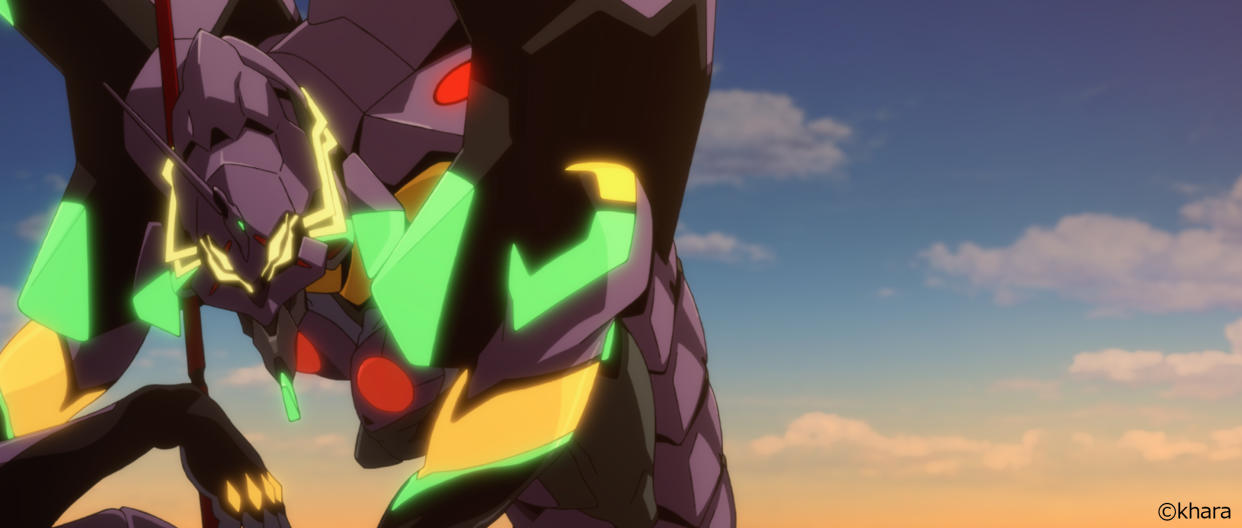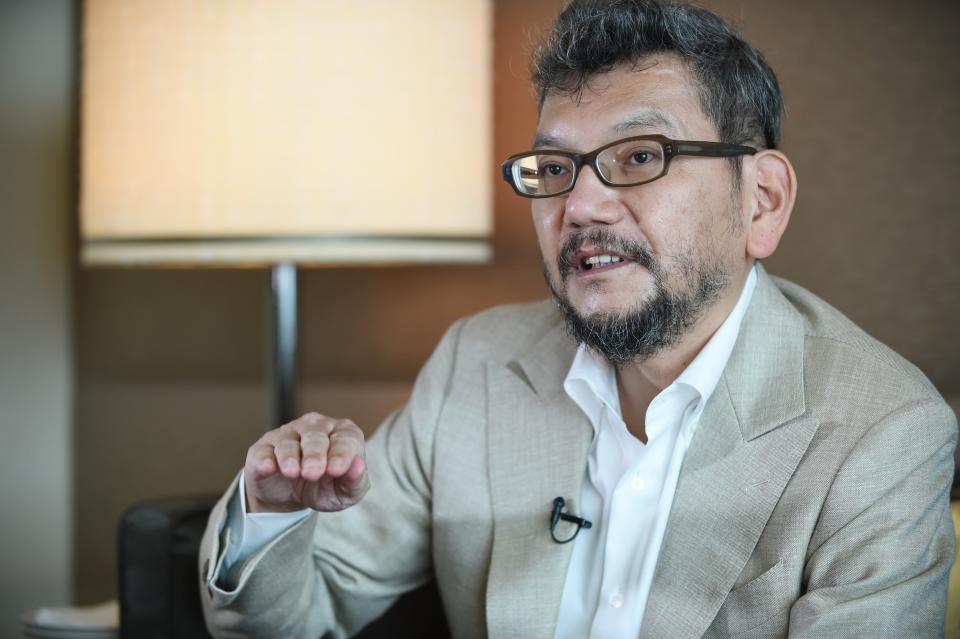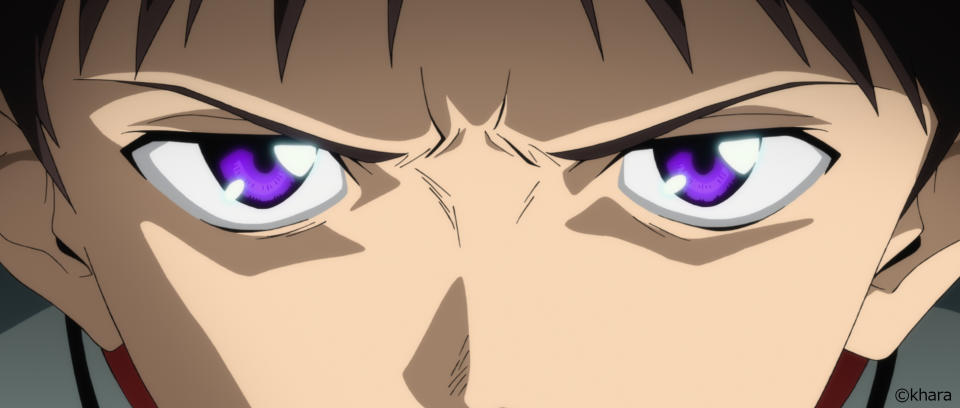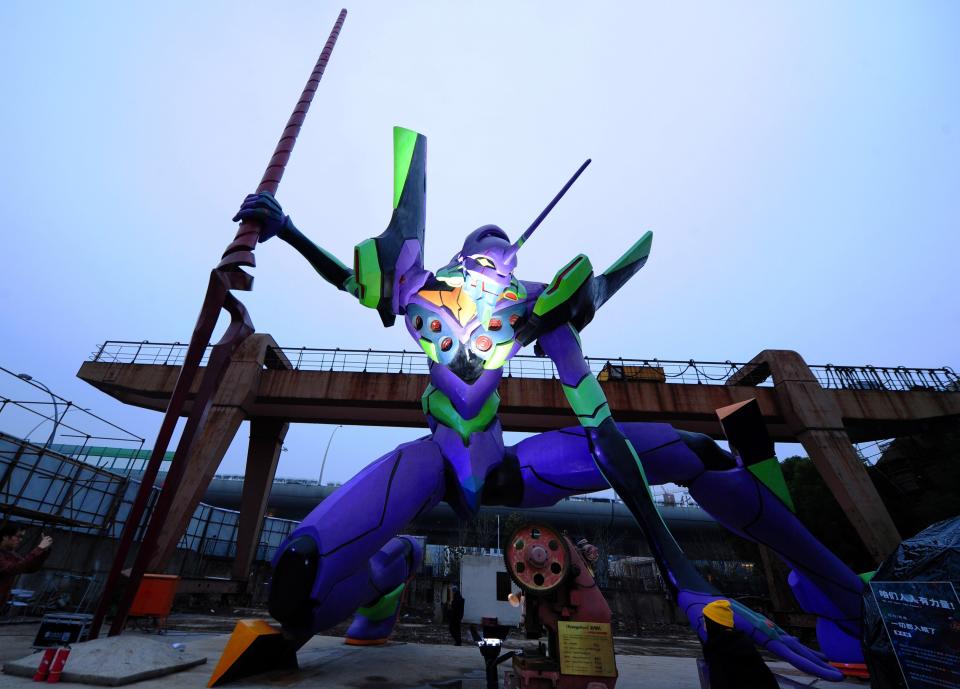Farewell to ‘Neon Genesis Evangelion’ — All Three of Them

- Oops!Something went wrong.Please try again later.
- Oops!Something went wrong.Please try again later.
Shinji Ikari isn’t a perfect person. He’s actually kind of a mess, but not without damn good reason: His mother died when he was 3 years old, his father abandoned him, and his entire world view has been shaped by the people around him, who try to maneuver Shinji any which way they’d like. On top of all that, he has to deal with all the typical stresses of being a teenager while regularly hopping into a giant biomechanical robot in order to defend humanity from the threat of monstrous beings tellingly referred to as “Angels.” And with each new iteration of the pioneering anime “Neon Genesis Evangelion,” Shinji relives this cycle of death, depression, and rebirth all over again.
“Neon Genesis Evangelion” completed its run on Japanese television in 1996; a quarter century later, the franchise it launched is more popular than ever. Recent years have seen the original series and its two feature-length follow-ups reach new audiences on Netflix and Blu-ray, as well as the completion of creator Hideaki Anno’s third telling of Shinji’s story, “Rebuild of Evangelion.” After topping the 2021 box office in its native country, the fourth and final “Rebuild” film, “Evangelion: 3.0+1.01 Thrice Upon a Time,” screens across the United States this week — at the end of a year when “Evangelion” entered the cultural conversation once more thanks to its influence on the mysterious entity at the center of Jordan Peele’s “Nope.”
More from IndieWire
For the curious and the unacquainted, getting to the bottom of all this fuss over Evas — the series’ shorthand for its titular mechs — and Angels might seem like a lot of work. “Evangelion” has grown into a behemoth: It’s a TV show and a number of feature films, each one tacitly connected to the work that came before — and that’s bound to turn off newcomers.
But there’s a simplicity to the seemingly complex nature of “Evangelion,” which is an ongoing journey as much as it is various individual works of art. It starts with Anno’s 26-episode TV series, known as both one of the cornerstones of mecha anime (i.e. anime where robots play a prominent role) and something of an alt-kid mecha anime designed for audiences interested in the humanity and psychology behind the mechanical and monstrous. In actuality, the series builds on themes already present in other mecha anime — particularly “Mobile Suit Gundam” and its myriad continuations — hyper-fixating on one bit in particular: the psychological toll that becoming a weapon of mass destruction takes on a fragile mind. That fragile mind is none other than Shinji Ikari.
Over the series’ original run, viewers watched as Anno slowly but surely moved both his characters and the audience toward certain destruction. More often than not, “Neon Genesis Evangelion” is a mirror image of Shinji’s frame of mind, sometimes excruciatingly insular in how it embraces the reality of being a mentally ill teenager in a world that tries to break him down at every turn. And break down it does, right down to the animation, as budgetary restrictions and production delays resulted in an overtly experimental two-part finale. It offers a concrete enough ending that essentially boils down to Shinji attending a metaphysical therapy session (climaxing with a round of applause from mental images of everyone he’s ever met), resulting in a conclusion that’s more interested in tying up themes and psychological threads than any distinct plot points. As so often happens with any truly challenging work of art, and in a prelude to the ends of “The Sopranos” and “Lost,” audience reaction was unfavorable.
Then came a second attempt at telling the tale of “Evangelion”: two films that condensed the series into a digestible recap and a revised ending. Originally meant to simply tell the same story, both “Death and Rebirth” and “The End of Evangelion” evolved into something even more challenging and pointed than the series itself. The former was exactly what was expected: a retread of the first 24 episodes that existed to reestablish the universe for an unfamiliar audience in a theatrical release. The latter was something altogether groundbreaking: It wasn’t just a massive, beautifully animated, end-of-the-world epic that offered a new narrative endpoint, but a doubling down on all the experimentation and ambiguity that came with the original finale. It was a battle cry against fans who felt entitled to a new ending, made by a man who was navigating the weight of being a divisive filmmaker, the onslaught of death threats and harassment that followed the end of the TV series, and the dark mental frame of mind it left him in. It wasn’t just another ending, but meant to serve as the definitive ending of the series. Until it wasn’t.
It was then time for the entire “Evangelion” universe to get a makeover with no limitations. The “Rebuild of Evangelion” series began in 2007 with “Evangelion 1.0 You Are (Not) Alone,” recreating the early episodes of “Neon Genesis Evangelion” with a new coat of paint that brought the series into the 21st century. As with “The End of Evangelion,” “Rebuild” began to show signs of divergence in its second installment, “Evangelion 2.0 You Can (Not) Advance,” implying that changes were a-comin’ for Shinji and company. The third film, “Evangelion 3.0 You Can (Not) Redo” skyrocketed the series to entirely new terrain. It was less as though Anno was retelling “Evangelion” for a new world and instead giving us a wholly unique journey. The fourth film took nine years to finish, but once it rolled out, it was clear this wasn’t just a way to close out one installment of “Evangelion.” “Thrice Upon A Time” was a way to truly end a series that both Anno and the audience had dedicated decades to.
“Neon Genesis Evangelion” can be seen as the equivalent of a roguelike video game. The TV series and the two film series follow the same path – Shinji is recruited to fight Angels, humanity fails at defending itself in some capacity, and a cataclysmic event is triggered by the teenage protagonist – but the journey and results always vary. In trying to complete the game, we find ourselves experiencing a variety of failures, be it because of the tools given to us, the lack of knowledge of our own situation, exterior elements that can’t be navigated, or, most importantly, because we weren’t ready for that journey to actually come to its intended ending.
The three main journeys that comprise “Evangelion” are all so tonally different, they can’t be considered mere recreations of the same work. Take the original series and its often meditative episode form: Television, more than film, offers time to let characters just exist and develop over an extended period of time. But the limitations of time and finance placed on anime production houses play a role as well. Every single episode of “Neon Genesis Evangelion” – and this even includes the episode that’s primarily a clip show – is perfectly designed as a small piece of a whole. There is never a false step in the series, with even individual interactions that at first seem meaningless building to a grander payoff. But there are false steps in Shinji’s own journey, just as there will be in “The End of Evangelion” and along the long and winding road to “Thrice Upon A Time.”
To younger viewers, Shinji can come off as a nuisance — there are plenty of posts on the Internet making fun of him for crying and complaining so much. But such responses can change as the viewer watches and grows to understand both the show and the character. We’re all a little lost and angry, confused about our place in the world and how our existence will affect others, and so much of what “Evangelion” looks like is because Hideaki Anno has clearly felt the same way.

AFP / Getty Images
“Neon Genesis Evangelion” is an almost unfiltered version of this work. It’s, at its purest, an existential series that aptly bounces between the highs and lows of being alive, and even ends with the kind of bittersweet note you’d expect. For years, people considered Shinji’s breakthrough the happier of “Evangelion” endings, especially compared to the overwhelming psychosexual trauma Shinji faces in “The End of Evangelion.” But it’s still hard to consider it a positive outcome. Everything about the series, even in its most exciting moments, is designed to challenge the idea that any of this is particularly cool. There’s a sterility to every bit of gorgeous animation, an undeniable distance between the characters (as well as the audience) that can’t be closed no matter how hard they try, that makes the series finale a hollow victory of sorts.
“The End of Evangelion,” by contrast, is a horror film from start to finish. It’s focused on how deeply messed up every bit of “Neon Genesis Evangelion” and its aftermath is — in part because of Anno’s mental state at the time of production, but also because this story was never meant to end optimistically. “The End of Evangelion” embraces the grotesque and the confrontational at every turn, whether it’s the body horror that persists throughout, the way the audio becomes a cacophony of voices and sound effects ringing through a broken mind (the film’s iconic song, “Kom Susser Tod”, or “Come Sweet Death”, feels of a piece with this), and even the distinct pivot away from animation into live-action. As Esther Rosenfield notes in her excellent piece on the film, “The End of Evangelion” resembles the experimental works of Stan Brakhage: “Everything in a Brakhage film is meant to be part of one whole. ‘The End of Evangelion’ similarly concocts a coherent ‘whole’ image out of relative incoherence.” It’s intended to create a sense of what it’s like to exist in Shinji’s (and Anno’s) mind, right down to the creator’s hate mail being loosely incorporated into the picture.
If “End of Evangelion” is cinema borne out of depression, out of irrationality, and/or out of sheer spite, “Thrice Upon A Time” is the result of true growth and almost like a film developed by someone who’d recently started SSRIs and learned to experience the world in a new capacity. The “Rebuild” series isn’t just a feat of technological advancement, with the incorporation of new technology and computer animation taking some of the series’ action sequences to a new level. It rewrites the way that both we and the director engage with “Evangelion.” It’s hard not to look at the “Rebuild” films as their own kind of experiment, and an altogether messier one than “The End of Evangelion.” They want to exist as a remake, a continuation, and a reflection of where Anno and cinema are in their respective histories.

courtesy of GKids
As oddly structured as they are, the “Rebuild” films are the most interesting to dissect, largely because of how flawed and different they each are. The interest in a straight remake gets thrown aside to embrace the fractured identities within “Evangelion” (be it Anno’, Shinji’s, or the series’). It’s outright fascinating. The action of the two first films, which become more of a showcase of fanservice than anything else, are eschewed in the third film of the series, which feels like one of the show’s meditative episodes stretched to feature length. It demonstrates maybe the most important bit of “Evangelion”: Shinji being broken down beyond recognition. As an empty shell of a person, there is nothing left to do but rebuild — and that’s precisely what the series’ crowning glory, “Thrice Upon A Time,” does.
“Thrice Upon A Time” doesn’t rebuild the series — it rebuilds Shinji and embraces what it means to be alive. It’s a film that could easily function on its own as part of the “Rebuild” tetralogy, but it needs the baggage of all that’s come before it — actively referencing imagery from past cycles of “Evangelion” — for maximum impact.It employs the same meditative filmmaking as “You Can (Not) Redo,” dedicating a large portion of its runtime to showing how its protagonists, now working in a pastoral town, are rehabilitated after the end of the world. But rather than wallowing in depression, it shows a path out. “Thrice Upon a Time” takes in the beauty of what it means to be part of an ever-changing world. In a first for Anno, the film feels defiant in its sincere optimism, actively confronting the entire history of “Evangelion” and all of the highs and lows that came with it, down to how its climactic scenes challenge how its animation is presented in a fresh way.

Hai Xin/ Xinhua News Agency / Getty Ima
There are too many threads – too many runs through the game, extending to a number of manga and light novel spin-offs – to ever create a concrete analysis of “Neon Genesis Evangelion,” but that’s what makes the series so fun amidst the exhaustion of it all. These works that exist as individual products, loosely exploring the same characters trapped in the same story, complement each other fascinatingly. They’re individual pieces and a part of a whole, just like Shinji is a part of his world, and just like we, the audience, are a part of our own world. As the series comes to a close, it’s time for Shinji to truly live, just as it’s time for the audience and Anno to truly explore what exists outside of “Evangelion.”
It’s a little bit corny to think of it in such a simplistic and humanist way, but there’s something especially moving about watching Anno move from a work that’s so deeply identified with depression into something that now wants to embrace the beauty of existence, however hard it might be. And every time we revisit “Evangelion,” whether it’s the sad one, the happy one, the bittersweet one, or even one of the less serious side ones like the casual teen drama with no Angels present whatsoever, we can expect to find a part of ourselves and our fragile identities reflected, if only for a brief moment.
Fathom Events will screen Evangelion 3.0 + 1.01 Thrice Upon a Time in theaters December 6, 8, and 11.
Best of IndieWire
Martin Scorsese's Favorite Movies: 53 Films the Director Wants You to See
Quentin Tarantino's Favorite Movies: 48 Films the Director Wants You to See
New Movies: Release Calendar for December 2, Plus Where to Watch the Latest Films
Sign up for Indiewire's Newsletter. For the latest news, follow us on Facebook, Twitter, and Instagram.
